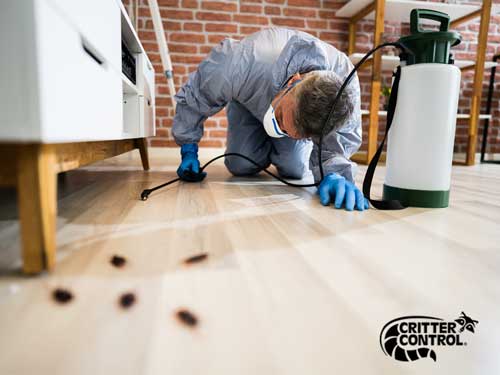A1 Bed Bug Exterminator Charlotte - Specialized Bed Bug Removal
A1 Bed Bug Exterminator Charlotte - Specialized Bed Bug Removal
Blog Article
Bed Insect Therapy Breakdown: Contrasting Chemical Vs. Non-Chemical Solutions
In the world of insect control, specifically when taking care of the persistent problem of bed insects, the choice between chemical and non-chemical treatment remedies can be an essential one. Both approaches offer distinct benefits and disadvantages, affecting factors such as performance, safety and security factors to consider, and total price. By checking out the nuanced information of each technique, a clearer understanding of which course to pursue in addressing a bed pest problem can be attained.
Efficiency of Chemical Treatments
Chemical therapies for bed bug invasions have been commonly acknowledged for their powerful and quick efficiency in removing these bugs. When considering the effectiveness of chemical therapies, it is essential to comprehend that they can offer a complete and quick solution to a bed bug problem. Professional pest control men commonly count on insecticides to target bed insects at different stages of their life process, consisting of eggs, grownups, and fairies. These chemicals generally function by interrupting the bed bugs' anxious system, causing paralysis and eventual death.
Moreover, chemical therapies have the advantage of using residual impacts, implying that they can continue to remove bed insects also after the initial application. This residual action is specifically helpful in combating any type of prospective re-infestations. Additionally, the fast action of chemical treatments can bring relief to people facing extreme bed insect infestations, enabling them to reclaim control of their living areas quickly.
Safety And Security Issues With Chemical Solutions
One vital aspect that needs mindful factor to consider when utilizing chemical remedies for bed pest therapy is making sure the security of residents and the environment. Exposure to certain chemicals used in bed pest therapies can lead to respiratory system issues, skin irritation, or other adverse responses, especially in people with pre-existing conditions or sensitivities.
Furthermore, the environmental influence of chemical solutions is one more considerable factor to consider. Some pesticides made use of in bed bug treatments may be unsafe to advantageous pests, wild animals, and communities if they leach right into the soil or water systems. It is important to utilize chemical therapies carefully, complying with security guidelines, and taking into consideration less poisonous alternatives to reduce these threats and make sure the secure and reliable administration of bed pest problems.
Advantages of Non-Chemical Approaches
Thinking about the possible safety worries and ecological impact related to chemical remedies for bed bug therapy, exploring non-chemical strategies offers a promising option with several distinctive advantages. Non-chemical techniques provide a more secure option for houses, specifically those with family pets, children, or people sensitive to extreme chemicals. These approaches get rid of the dangers of direct exposure to hazardous materials, reducing the possibility for unfavorable wellness impacts. In addition, non-chemical treatments are eco-friendly, as they do not add to air or water contamination, making them a lasting choice for parasite control.
Furthermore, non-chemical services can be effective in targeting bed insects, including hard-to-reach locations where chemical treatments may not pass through. home pest extermination Methods such as warm treatment, vacuuming, heavy steam cleansing, and cushion encasements supply complete removal without making use of harmful chemicals. Additionally, non-chemical approaches can be less disruptive, calling for minimal preparation and enabling for quicker reentry right into treated areas. Generally, going with non-chemical bed insect therapy methods not just focuses on security and ecological protection however also makes certain reliable and detailed insect control.
Limitations of Non-Chemical Treatments

In addition, non-chemical treatments commonly call for numerous applications to achieve successful obliteration. This can be time-consuming and may not always assure full elimination of all bed pests and their eggs, specifically in hard-to-reach or covert places.
In addition, the success of non-chemical treatments greatly counts on proper application and thoroughness, which can be testing for people without specialist experience. Inadequate application of non-chemical techniques might lead to insufficient obliteration, causing persistent problems and the need for additional therapies.
For that reason, while non-chemical therapies have their advantages, it is important to recognize these constraints and consider them when go to this site figuring out the most effective strategy for managing bed pest invasions.
Cost Comparison: Chemical Vs. Non-Chemical Options
Given the constraints connected with non-chemical therapies, an important aspect to review in the context of bed insect monitoring is the price contrast in between chemical and non-chemical alternatives. In contrast, non-chemical therapies like warmth therapy or steam can be much more pricey, with prices ranging from $1,000 to $6,000 for an entire home. While the first cost of chemical treatments might appear reduced, multiple treatments might be called for to fully remove the infestation, possibly boosting the general cost.
Verdict

Thinking about the prospective safety and security problems and ecological effect associated with chemical services for bed pest treatment, checking out non-chemical approaches provides an encouraging option with a number of distinct benefits.Given the restrictions connected with non-chemical therapies, a vital facet to review in the context of bed bug management is the price contrast in between chemical and non-chemical alternatives. In comparison, non-chemical therapies like warmth therapy or vapor can be much more pricey, with expenses varying from $1,000 to $6,000 for a whole home. While the first expense of chemical therapies may appear lower, numerous treatments may be required to completely eliminate the problem, potentially enhancing the overall cost.In conclusion, when comparing chemical and non-chemical bed pest therapy choices, it is crucial to take into consideration performance, safety and security, advantages, restrictions, and price.
Report this page